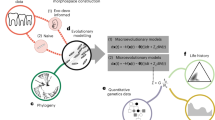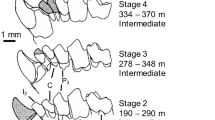Abstract
The developmental processes that contribute to variation of morphological traits are the subject of considerable interest when attempting to understand phenotypic evolution. It is well demonstrated that most characteristics of tooth pattern can be modified by tinkering conserved signal pathways involved in dental development. This effect can be evaluated by comparing developmental models with naturally occurring variation within explicit phylogenetic contexts. Here, we assess whether evolutionary changes in lower molar (M) ratios among platyrrhines were channelled by alterations in the balance of activators and inhibitors as predicted by the inhibitory cascade (IC) model (Kavanagh et al. in Nature 449:427–432, 2007). Ordinary linear regression adjusted to M2/M1 versus M3/M1 ratios of 38 species of platyrrhines indicated that the slope and intercept were significantly different from the IC model. Conversely, when the phylogeny was incorporated into the regression analyses (PGLS), variation in molar ratios did not differ from the developmental model. PGLS also showed that changes in molar proportions are not an allometric effect associated with body size. Discrepancies between phylogenetically corrected and non-corrected analyses are mainly due to the departure of Callitrichines from the predicted values. This subfamily displays agenesis of M3 with higher than expected M2/M1 ratios, indicating that M3 fails to develop even when the inhibition by M1 on the subsequent molars is not increased. Our results show that evolution in molar ratios is concordant with slight changes in the proportion of activators and inhibitors that regulate molar development; however, other processes are required to account for variation in the number of teeth.



Similar content being viewed by others
References
Blomberg, S. P., Garland, T., & Ives, A. R. (2003). Testing for phylogenetic signal in comparative data: Behavioral traits are more labile. Evolution, 57(4), 717–745. doi:10.1111/j.0014-3820.2003.tb00285.x.
Cai, J., Cho, S.-W., Kim, J.-Y., Lee, M.-J., Cha, Y.-G., & Jung, H.-S. (2007). Patterning the size and number of tooth and its cusps. Developmental Biology, 304(2), 499–507. doi:10.1016/j.ydbio.2007.01.002.
Catón, J., Bringas, P, Jr, & Zeichner-David, M. (2005). IGFs increase enamel formation by inducing expression of enamel mineralizing specific genes. Archives of Oral Biology, 50(2), 123–129. doi:10.1016/j.archoralbio.2004.11.012.
Cho, S.-W., Kwak, S., Woolley, T. E., Lee, M.-J., Kim, E.-J., Baker, R. E., et al. (2011). Interactions between Shh, Sostdc1 and Wnt signaling and a new feedback loop for spatial patterning of the teeth. Development, 138(9), 1807–1816. doi:10.1242/dev.056051.
Drummond, A. J., Ho, S. Y. W., Phillips, M. J., & Rambaut, A. (2006). Relaxed phylogenetics and dating with confidence. PLoS Biology, 4(5), e88. doi:10.1371/journal.pbio.0040088.
Drummond, A. J., & Rambaut, A. (2007). BEAST: Bayesian evolutionary analysis by sampling trees. BMC Evolutionary Biology, 7, 214. doi:10.1186/1471-2148-7-214.
Felsenstein, J. (1985). Phylogenies and the comparative method. The American Naturalist, 125(1), 1–15.
Fleagle, J. G. (1999). Primate adaptation and evolution (2nd ed.). San Diego: Academic Press.
Freckleton, R. P., Cooper, N., & Jetz, W. (2011). Comparative methods as a statistical fix: The dangers of ignoring an evolutionary model. The American Naturalist, 178(1), E10–E17. doi:10.1086/660272.
Garland, T., Bennett, A. F., & Rezende, E. L. (2005). Phylogenetic approaches in comparative physiology. Journal of Experimental Biology, 208(16), 3015–3035. doi:10.1242/jeb.01745.
Gould, S. J. (1977). Ontogeny and phylogeny. Cambridge, MA: Belknap Press of Harvard University Press.
Hammer, Ø., Harper, D. A. T., & Ryan, P. D. (2001). PAST: Paleontological statistics software package for education and data analysis. Palaeontologia Electronica, 4(1), 9.
Hartwig, W. C. (1996). Perinatal life history traits in New World monkeys. American Journal of Primatology, 40(2), 99–130. doi:10.1002/(SICI)1098-2345(1996)40:2<99:AID-AJP1>3.0.CO;2-V.
Harvey, P. H., & Pagel, M. D. (1991). The comparative method in evolutionary biology (1st ed.). Oxford: Oxford University Press.
Henderson, E. (2007). Platyrrhine dental eruption sequences. American Journal of Physical Anthropology, 134(2), 226–239. doi:10.1002/ajpa.20658.
Hendrikse, J. L., Parsons, T. E., & Hallgrímsson, B. (2007). Evolvability as the proper focus of evolutionary developmental biology. Evolution & Development, 9(4), 393–401. doi:10.1111/j.1525-142X.2007.00176.x.
Hu, B., Nadiri, A., Kuchler-Bopp, S., Perrin-Schmitt, F., Peters, H., & Lesot, H. (2006). Tissue engineering of tooth crown, root, and periodontium. Tissue Engineering, 12(8), 2069–2075. doi:10.1089/ten.2006.12.2069.
Ives, A. R., & Zhu, J. (2006). Statistics for correlated data: Phylogenies, space, and time. Ecological Applications, 16(1), 20–32.
Jernvall, J. (2000). Linking development with generation of novelty in mammalian teeth. Proceedings of the National Academy of Sciences, 97(6), 2641–2645. doi:10.1073/pnas.050586297.
Jumlongras, D., Lin, J.-Y., Chapra, A., Seidman, C. E., Seidman, J. G., Maas, R. L., et al. (2004). A novel missense mutation in the paired domain of PAX9 causes non-syndromic oligodontia. Human Genetics, 114(3), 242–249. doi:10.1007/s00439-003-1066-6.
Kanazawa, E., & Rosenberger, A. (1988). Reduction index of the upper M2 in marmosets. Primates, 29(4), 525–533. doi:10.1007/BF02381139.
Kavanagh, K. D., Evans, A. R., & Jernvall, J. (2007). Predicting evolutionary patterns of mammalian teeth from development. Nature, 449(7161), 427–432. doi:10.1038/nature06153.
Klein, M. L., Nieminen, P., Lammi, L., Niebuhr, E., & Kreiborg, S. (2005). Novel mutation of the initiation codon of PAX9 causes oligodontia. Journal of Dental Research, 84(1), 43–47. doi:10.1177/154405910508400107.
Ledevin, R., Quéré, J.-P., & Renaud, S. (2010). Morphometrics as an insight into processes beyond tooth shape variation in a bank vole population. PLoS ONE, 5(11), e15470. doi:10.1371/journal.pone.0015470.
Lemey, P., Salemi, M., & Vandamme, A.-M. (Eds.). (2009). The phylogenetic handbook: A practical approach to phylogenetic analysis and hypothesis testing (2nd ed.). Cambridge, UK: Cambridge University Press.
Lidral, A. C., & Reising, B. C. (2002). The role of MSX1 in human tooth agenesis. Journal of Dental Research, 81(4), 274–278. doi:10.1177/154405910208100410.
Marroig, G., & Cheverud, J. M. (2005). Size as a line of least evolutionary resistance: Diet and adaptive morphological radiation in New World monkeys. Evolution, 59(5), 1128–1142. doi:10.1111/j.0014-3820.2005.tb01049.x.
Müller, G. B. (2007). Evo–devo: Extending the evolutionary synthesis. Nature Reviews Genetics, 8(12), 943–949. doi:10.1038/nrg2219.
Nieminen, P. (2009). Genetic basis of tooth agenesis. Journal of Experimental Zoology. Part B, Molecular and Developmental Evolution, 312B(4), 320–342. doi:10.1002/jez.b.21277.
Nieminen, P., Arte, S., Tanner, D., Paulin, L., Alaluusua, S., Thesleff, I., et al. (2001). Identification of a nonsense mutation in the PAX9 gene in molar oligodontia. European Journal of Human Genetics: EJHG, 9(10), 743–746. doi:10.1038/sj.ejhg.5200715.
Opazo, J. C., Wildman, D. E., Prychitko, T., Johnson, R. M., & Goodman, M. (2006). Phylogenetic relationships and divergence times among New World monkeys (Platyrrhini, Primates). Molecular Phylogenetics and Evolution, 40(1), 274–280. doi:10.1016/j.ympev.2005.11.015.
Orme, C. D. L., Freckleton, R. P., Thomas, G. H., Petzoldt, T., Fritz, S. A. & Isaac, N. J. B. (2012). Caper: Comparative analyses of phylogenetics and evolution. In R. R package version 0.5. Available: http://cran.r-project.org/web/packages/caper/index.html. Accessed 28 June 2012.
Oster, G., & Alberch, P. (1982). Evolution and bifurcation of developmental programs. Evolution, 36(3), 444–459. doi:10.2307/2408093.
Parker, J. (2011). Morphogens, nutrients, and the basis of organ scaling. Evolution & Development, 13(3), 304–314. doi:10.1111/j.1525-142X.2011.00481.x.
Pereira, T. V., Salzano, F. M., Mostowska, A., Trzeciak, W. H., Ruiz-Linares, A., Chies, J. A. B., et al. (2006). Natural selection and molecular evolution in primate PAX9 gene, a major determinant of tooth development. Proceedings of the National Academy of Sciences, 103(15), 5676–5681. doi:10.1073/pnas.0509562103.
Perelman, P., Johnson, W. E., Roos, C., Seuánez, H. N., Horvath, J. E., Moreira, M. A. M., et al. (2011). A molecular phylogeny of living primates. PLoS Genetics, 7(3), e1001342. doi:10.1371/journal.pgen.1001342.
Perez, S. I., Klaczko, J., & dos Reis, S. F. (2012). Species tree estimation for a deep phylogenetic divergence in the New World monkeys (Primates: Platyrrhini). Molecular Phylogenetic and Evolution, 65, 621–630. doi:10.1016/j.ympev.2012.07.014.
Plavcan, J. M. (1990). Sexual dimorphism in the dentition of extant anthropoid primates. Ph.D. Dissertation, University of Michigan Microfilms.
Plavcan, J. M., & Gomez, A. (1993). Dental scaling in the callitrichinae. International Journal of Primatology, 14(1), 177–192. doi:10.1007/BF02196511.
Plikus, M. V., Zeichner-David, M., Mayer, J.-A., Reyna, J., Bringas, P., Thewissen, J. G. M., et al. (2005). Morphoregulation of teeth: Modulating the number, size, shape and differentiation by tuning Bmp activity. Evolution & Development, 7(5), 440–457. doi:10.1111/j.1525-142X.2005.05048.x.
Polly, P. D. (2007). Evolutionary biology: Development with a bite. Nature, 449(7161), 413–415. doi:10.1038/449413a.
R-Development Core Team (2012). R: A language and environment for statistical computing. R Foundation for statistical Computing, Vienna, Austria. http://www.R-project.org/.
Renvoisé, E., Evans, A. R., Jebrane, A., Labruère, C., Laffont, R., & Montuire, S. (2009). Evolution of mammal tooth patterns: New insights from a developmental prediction model. Evolution, 63(5), 1327–1340. doi:10.1111/j.1558-5646.2009.00639.x.
Rohlf, F. J. (2001). Comparative methods for the analysis of continuous variables: Geometric interpretations. Evolution, 55(11), 2143–2160. doi:10.1111/j.0014-3820.2001.tb00731.x.
Rosenberger, A. L. (1984). Fossil New World monkeys dispute the molecular clock. Journal of Human Evolution, 13(8), 737–742. doi:10.1016/S0047-2484(84)80023-8.
Rosenberger, A. L. (1992). Evolution of feeding niches in New World monkeys. American Journal of Physical Anthropology, 88(4), 525–562. doi:10.1002/ajpa.1330880408.
Rosenberger, A. L., Tejedor, M. F., Cooke, S., Halenar, L., & Pekar, S. (2009). Platyrrhine ecophylogenetics in space and time. In P. A. Garber, A. Estrada, J. C. Bicca-Marques, E. W. Heymann, & K. B. Strier (Eds.), South American primates: Comparative perspectives in the study of behavior, ecology and conservation (pp. 69–113). New York: Springer.
Salazar-Ciudad, I., & Jernvall, J. (2010). A computational model of teeth and the developmental origins of morphological variation. Nature, 464(7288), 583–586. doi:10.1038/nature08838.
Shingleton, A. W. (2011). Evolution and the regulation of growth and body size. In T. Flatt & A. Heyland (Eds.), Mechanisms of life history evolution. The genetics and physiology of life history traits and trade-offs (pp. 43–55). Oxford: Oxford University Press.
Smith, B. H. (1989). Dental development as a measure of life history in primates. Evolution, 43(3), 683–688. doi:10.2307/2409073.
Smith, R. J., & Jungers, W. L. (1997). Body mass in comparative primatology. Journal of Human Evolution, 32(6), 523–559. doi:10.1006/jhev.1996.0122.
Tejedor, M. F. (2008). The origin and evolution of Neotropical primates. Arquivos do Museu Nacional, 66, 251–269.
Tummers, M., & Thesleff, I. (2009). The importance of signal pathway modulation in all aspects of tooth development. Journal of Experimental Zoology. Part B, Molecular and Developmental Evolution, 312B(4), 309–319. doi:10.1002/jez.b.21280.
Ungar, P. S. (2007). Dental functional morphology: The known, the unknown and the unknowable. In P. S. Ungar (Ed.), Evolution of the human diet: The known, the unknown, and the unknowable, human evolution series (pp. 39–55). Oxford: Oxford University Press.
Wagner, G. P., & Altenberg, L. (1996). Perspective: Complex adaptations and the evolution of evolvability. Evolution, 50(3), 967–976. doi:10.2307/2410639.
Wildman, D. E., Jameson, N. M., Opazo, J. C., & Yi, S. V. (2009). A fully resolved genus level phylogeny of Neotropical primates (Platyrrhini). Molecular Phylogenetics and Evolution, 53(3), 694–702. doi:10.1016/j.ympev.2009.07.019.
Wilson, L. A. B., Madden, R. H., Kay, R. F., & Sánchez-Villagra, M. R. (2012). Testing a developmental model in the fossil record: Molar proportions in South American ungulates. Paleobiology, 38, 308–321. doi:10.1666/11001.1.
Wilson, D. E., & Reeder, D. M. (Eds.). (2005). Mammal species of the world: A taxonomic and geographic reference (3rd ed.). Baltimore, MD: Johns Hopkins University Press.
Acknowledgments
The authors would like to acknowledge the contribution of Michael Plavcan for providing dental measurements for several of the species analyzed here and for reading and commenting on the manuscript. This work was supported by Consejo Nacional de Investigaciones Científicas y Técnicas, Universidad Nacional de La Plata and Grants from the FONCyT, PICT-2011-0307 (V. B and S. I. P). P. N. G was supported by a fellowship from Alberta Innovates Health Solutions and the CIHR Training Program in Genetics, Child Development and Health (Alberta Children’s Hospital).
Conflict of interest
The authors have no conflict of interest to declare.
Author information
Authors and Affiliations
Corresponding author
Electronic supplementary material
Below is the link to the electronic supplementary material.
Rights and permissions
About this article
Cite this article
Bernal, V., Gonzalez, P.N. & Perez, S.I. Developmental Processes, Evolvability, and Dental Diversification of New World Monkeys. Evol Biol 40, 532–541 (2013). https://doi.org/10.1007/s11692-013-9229-4
Received:
Accepted:
Published:
Issue Date:
DOI: https://doi.org/10.1007/s11692-013-9229-4




